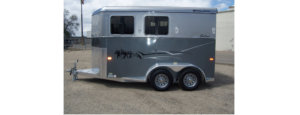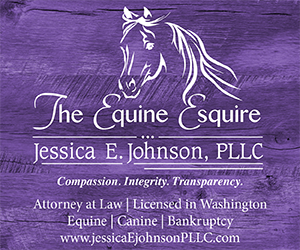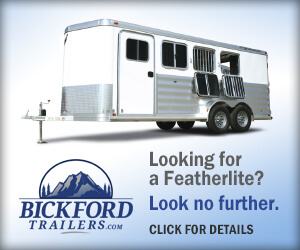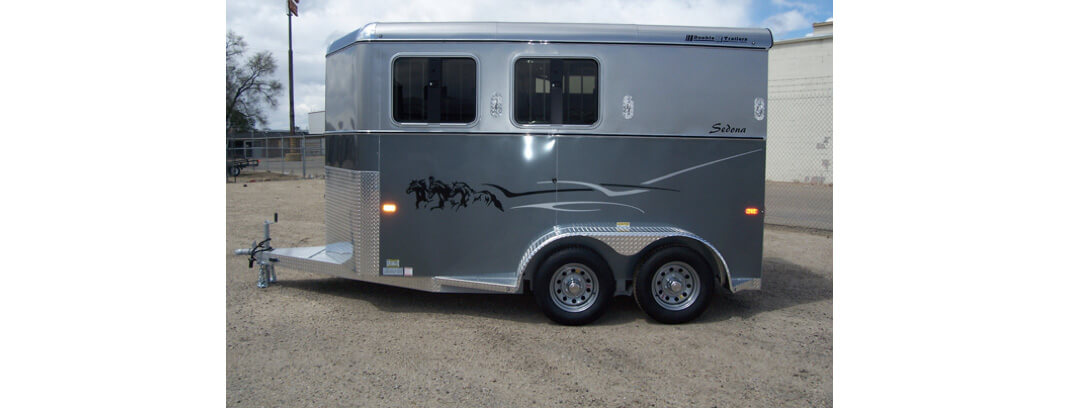Use Care in the Purchase of Your Horse’s “Ride”
by: Leigh Goodison Grieve
The most important thing before buying a horse trailer, whether it’s new or used, is to first measure your horse. This includes width, height (withers to ground/poll to the ground), and length (chest to tail/muzzle to tail). If you’ve owned a trailer you probably know what make and style will work best for you and your horse. Just bear in mind that manufacturing standards have changed over the years.
Most trailers built before the 1980’s were considerably smaller than those built over the past three decades. However, breeds other than short-backed Arabians are having difficulty fitting in some of the new slants. This is resulting in behavior problems when hauling, as well as extensive damage to the trailer by an unhappy horse. In most states there are no Lemon Laws on horse trailers, so if you experience buyer’s remorse there is little recourse open to you.
Determine beforehand:
 what size of trailer (height, capacity) you want vs. need
what size of trailer (height, capacity) you want vs. need- if you have an appropriately sized tow vehicle
- if a brake control unit is in your tow vehicle
- if the vehicle is capable of having a brake controller installed
- if your horse is going to fit comfortably in the trailer
BUYING NEW
The old adage, ‘you get what you pay for,’ also holds true with horse trailers. If a new trailer is cheap, so too will be the trailer quality. Be prepared to pay for a lot of ‘options,’ which could be anything from rubber mats to a spare tire. Warranties are only as good for as long as the manufacturer stays in business, and generally have a lot of fine print. They are not worth taking into account when purchasing.
Straight load vs. slant
Although the preference these days is slant trailers, consider that a side to side rocking motion is not a natural movement for a horse. A horse stops and starts comfortably with forward and backward motion. While there are a lot of experts who may claim that horses ride more comfortably in slants, the majority of trailers we see with horse-inflicted damage are slants, not straight loads. The exception to this is the horse that will scramble into a manger. If your horse will only haul in one type of trailer you should train it to haul in various scenarios, especially if getting out of a bad situation meant the only way out was in an unfamiliar trailer.
Aluminum vs. steel
Aluminum trailers became popular when gas prices began to rise and are not necessarily lighter. To make an aluminum frame as strong as steel, more material needs to go into building it. Steel framed trailers with aluminum skin have become popular for the same reason, as well as addressing rust issues here in the Pacific Northwest, however, the aluminum skin is extremely thin.
You should understand the manufacturing specifications on a new trailer before making the investment—don’t just take a salesman’s word on safety and stability—do comparative studies so you know exactly what you’re paying for.
Ramp vs. step up
While this is a personal preference it’s also about training. The problem with ramps is that they eventually become bowed from the horse’s weight, hinges rust and fail, and they become an expensive fix. Some trailers appear to have a step up too high for a horse, but a horse can be trained to back out of just about anything. Consider carefully whether you really need one.
BUYING USED
The variables on used trailers are so great it’s impossible to cover them all in a single column. Maintenance is everything. If you do your homework by reading back issues of this column and you can verify that a used trailer has been maintained the way we’ve talked about, then you are money ahead in purchasing a good, used one. Ask about regular maintenance (i.e., when wheel bearing repacks were last repacked—see July 2011 issue) and how frequently it was used. When trailers sit for long periods the wheel drums and brakes can get rusty and seize up, the grease in the wheel bearings deteriorates from lack of use and if there’s not much of it, will settle. Then when it gets hauled again it’s steel against steel (causing friction and unnecessary wear) until the grease heats up enough to lubricate. Peel back the floor mats and check the wood for rot or splits; with aluminum check for pitting. Check for kick marks on the rubber mats inside and if they go through to the outside walls. Water tanks usually end up leaking because owners forget to winterize or drain them. Check the carpeted area to see if there are any water stains, or rotted wood underneath. Look at the roof and check the caulking (for drying, pulling apart at seams, etc.), especially with aluminum trailers that may have been acid washed. Check tires for even wear on the treads and to rule out problems like a bent axle. Check for rust. Ask if you can take it for a road test. This will allow you to see if the lights and brakes work as well as discover hauling issues like a bent frame.
Purchasing a used trailer that requires several thousand dollars in repairs before it is safe and usable is worth considering if the seller will take into account what repairs are necessary and adjust their price accordingly.
Published February 2012 Issue

The Northwest Horse Source is an independently owned and operated print and online magazine for horse owners and enthusiasts of all breeds and disciplines in the Pacific Northwest. Our contemporary editorial columns are predominantly written by experts in the region, covering the care, training, keeping and enjoyment of horses, with an eye to the specific concerns in our region.






